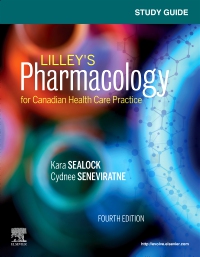
Study Guide for Lilley's Pharmacology for Canadian Health Care Practice - Elsevier eBook on VitalSource, 4th Edition
Elsevier eBook on VitalSource

Now $29.69
Ensure your mastery of need-to-know Canadian pharmacology nursing principles with Study Guide for Lilley’s Pharmacology for Canadian Health Care Practice, 4th Edition. Designed to accompany the Lilley’s Pharmacology for Canadian Health Practice 4th Edition textbook, this dynamic study guide helps you better understand, retain, and apply the information and concepts from each chapter of the text. Worksheets for each chapter include multiple-choice questions, critical thinking and application questions, case studies, plus a wealth of other learning activities to fully prepare you for your credentialing exams.
Newer Edition Available
Study Guide for Lilley's Pharmacology for Canadian Health Care Practice - Elsevier eBook on VitalSource
-
- Chapter review and examination preparation is included in each chapter worksheet and contains a number of application-based NCLEX® style practice questions, including at least one alternate-item question per chapter.
- Focus on prioritization features at least one prioritization exercise in which you must evaluate a clinical scenario and answer the question: "What is the nurse’s best action?" These exercises provide practice in identifying the most important, need-to-know nursing actions.
- Overview of Dosage Calculations section features explanations of key drug calculations concepts, sample drug labels, practice problems, and a practice quiz.
- UNIQUE! Cartoon-illustrated study tips expands upon the study skills tips that are included on the accompanying Evolve site.
- Answers for all exercises are provided at the back of the book to facilitate self-study.
- Chapter-by-chapter worksheets are divided into three main sections: chapter review and examination preparation; critical thinking and application questions; and case studies.
- Question variety includes fill-in-the-blank, multiple choice, labelling and ordering, matching, and short answer.
-
- NEW! Thoroughly updated content reflects the organization and updated information housed in the fourth edition of Lilley’s Pharmacology for Canadian Health Care Practice.
-
STUDENT STUDY TIPS
WORK SHEETS:
Part One: Pharmacology Basics
1. Nursing Practice in Canada and Drug Therapy
2. Pharmacological Principles
3. Legal and Ethical Considerations
4. Patient-Focused Considerations
5. Gene Therapy and Pharmacogenomics
6. Medication Errors: Preventing and Responding
7. Patient Education and Drug Therapy
8. Over-the-Counter Drugs and Natural Health Products
9. Vitamins and Minerals
10. Principles of Drug Administration
Part Two: Drugs Affecting the Central Nervous System
11. Analgesic Drugs
12. General and Local Anaesthetics
13. Central Nervous System Depressants and Muscle Relaxants
14. Central Nervous System Stimulants and Related Drugs
15. Antiepileptic Drugs
16. Antiparkinsonian Drugs
17. Psychotherapeutic Drugs
18. Substance Misuse
Part Three: Drugs Affecting the Autonomic Nervous System
19. Adrenergic Drugs
20. Adrenergic-Blocking Drugs
21. Cholinergic Drugs
22. Cholinergic-Blocking Drugs
Part Four: Drugs Affecting the Cardiovascular and Renal Systems
23. Antihypertensive Drugs
24. Antianginal Drugs
25. Heart Failure Drugs
26. Antidysrhythmic Drugs
27. Coagulation Modifier Drugs
28. Antilipemic Drugs
29. Diuretic Drugs
30. Fluids and Electrolytes
Part Five: Drugs Affecting the Endocrine System
31. Pituitary Drugs
32. Thyroid and Antithyroid Drugs
33. Antidiabetic Drugs
34. Adrenal Drugs
35. Women's Health Drugs
36. Men's Health Drugs
Part Six: Drugs Affecting the Respiratory System
37. Antihistamines, Decongestants, Antitussives, and Expectorants
38. Respiratory Drugs
Part Seven: Drugs Affecting the Gastrointestinal System and Nutrition
39. Acid-Controlling Drugs
40. Antidiarrheal Drugs and Laxatives
41. Antiemetic and Antinausea Drugs
42. Nutritional Supplements
Part Eight: Anti-infective and Anti-inflammatory Drugs
43. Antibiotics Part 1: Sulfonamides, Penicillins, Cephalosporins, Macrolides, and Tetracyclines
44. Antibiotics Part 2: Aminoglycosides, Fluoroquinolones, and Other Drugs
45. Antiviral Drugs
46. Antitubercular Drugs
47. Antifungal Drugs
48. Antimalarial, Antiprotozoal, and Anthelmintic Drugs
49. Anti-inflammatory and Antigout Drugs
Part Nine: Immune and Biological Modifiers and Chemotherapeutic Drugs
50. Immunosuppressant Drugs
51. Immunizing Drugs and Pandemic Preparedness
52. Antineoplastic Drugs Part 1: Cancer Overview and Cell Cycle - Specific Drugs
53. Antineoplastic Drugs Part 2: Cell Cycle - Nonspecific and Miscellaneous Drugs
54. Biological Response - Modifying Drugs and Antirheumatic Drugs
Part Ten: Miscellaneous Therapeutics: Hematological, Dermatological, Ophthalmic, and Otic Drugs
55. Anemia Drugs
56. Dermatological Drugs
57. Ophthalmic Drugs
58. Otic Drugs
OVERVIEW OF DOSAGE CALCULATIONSANSWERS (to worksheets and overview of dosage calculations)
Pharmaceutical Abbreviations



 as described in our
as described in our 